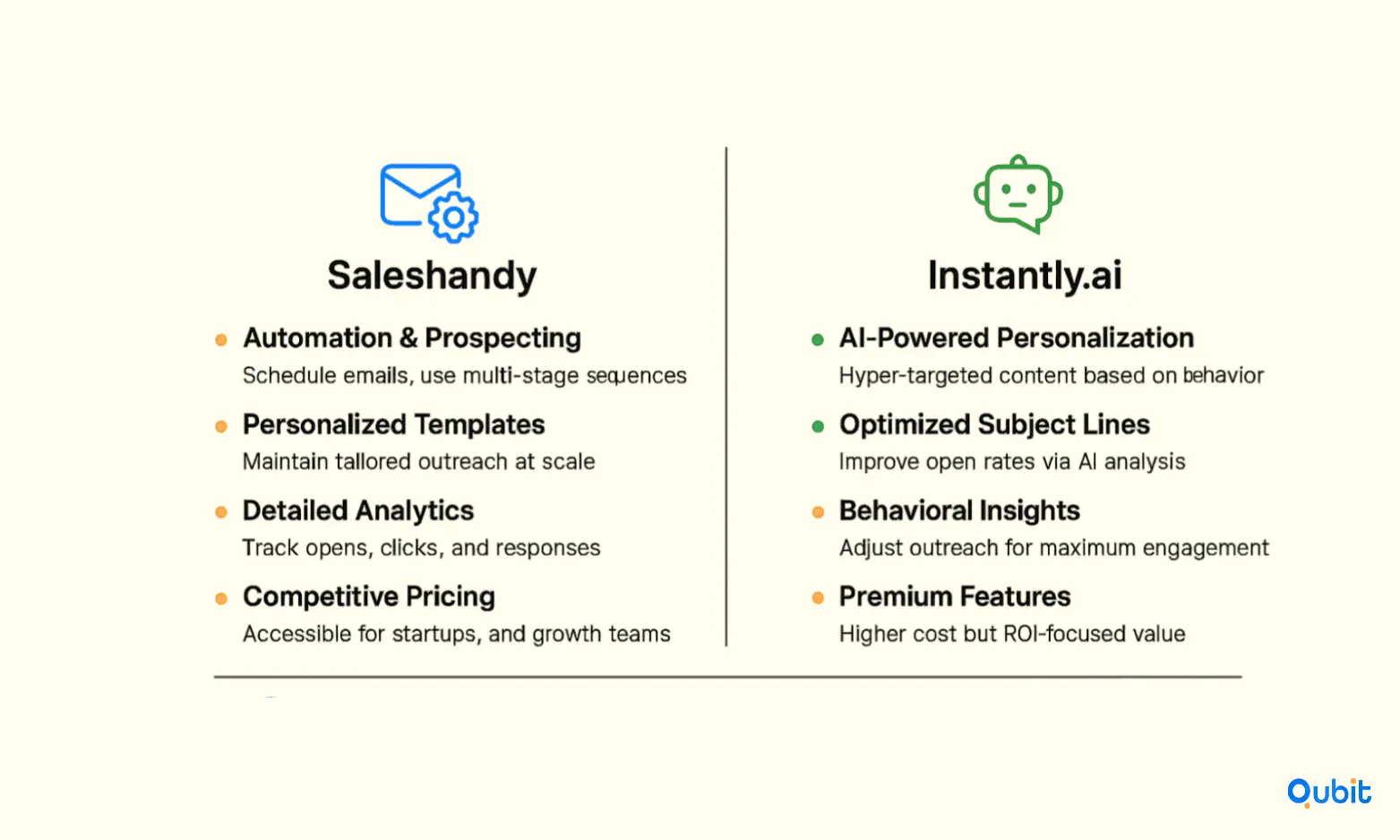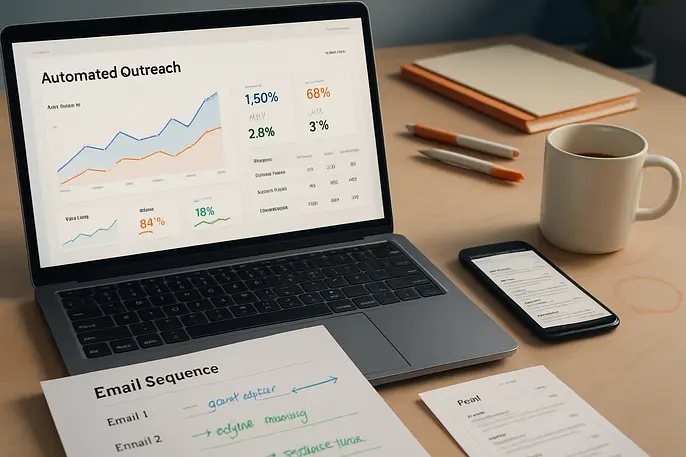Email outreach has evolved into a cornerstone of modern communication strategies, especially for businesses aiming to connect with prospects efficiently. Automation tools have revolutionized this process, offering a 25% boost in productivity and a 32% higher response rate. However, success in email outreach isn’t just about adopting software—it’s about aligning technology with a well-thought-out strategy.
For instance, understanding how to do startup outreach for investors can provide a solid framework for planning your campaigns. This section outlines how to do startup outreach for investors by providing a comprehensive framework that informs your overall strategy. By combining strategic planning with the right tools, businesses can streamline their outreach while maintaining a personal touch.
This article explores the essentials of automating outreach emails, including tool selection, cybersecurity considerations, pricing models, and advanced features that can elevate your campaigns.
Automating Cold Email Outreach: Key Rationale and Operational Pitfalls
Cold email automation has become a cornerstone for scaling outreach efforts, especially in industries where high-volume communication is essential. Businesses adopt automation to streamline processes, reduce manual workload, and drive growth. However, while the rationale for automation is compelling, operational challenges can hinder its effectiveness if not addressed.
Strategic Rationale for Automation
Automating cold email outreach offers clear advantages. It enables businesses to handle large-scale campaigns efficiently, ensuring consistent messaging across thousands of prospects. For example, SaaStr’s case study highlights how AI-driven business development representative (BDR) systems achieved a 3.6% positive reply rate, directly contributing to revenue growth. This demonstrates the potential of automation to not only save time but also deliver measurable results.
Additionally, the cold email software market is expanding rapidly, projected to grow from $1.2 billion to $3.5 billion between 2023 and 2032 at a compound annual growth rate (CAGR) of 12.5%. This trend underscores the increasing reliance on automation tools to meet evolving outreach demands.
Operational Pitfalls to Watch
Despite its benefits, automating cold email outreach comes with challenges that require careful management:
Domain Setup Issues
Poor domain setup can lead to deliverability problems, such as emails landing in spam folders or being blocked entirely. Ensuring proper domain authentication (e.g., SPF, DKIM, and DMARC) is critical to maintaining sender reputation and avoiding delays.Managing High Email Volumes
Automation tools can send thousands of emails daily, but handling responses effectively is equally important. Without a robust inbox management system, businesses risk missing valuable replies or overwhelming their teams with unorganized data.Cost Control
While automation reduces manual effort, it can become expensive if not optimized. Subscription fees for software, combined with additional costs for email tracking and analytics, can strain budgets. Businesses must evaluate tools carefully to balance functionality with affordability.Driving Growth Through Automation
Automation can accelerate growth by scaling outreach efforts, but it must be paired with strategic targeting. Tools like AI-driven prospecting platforms, as discussed in the ai-investor-prospecting, illustrate advanced methods for identifying high-value prospects.
By addressing these pitfalls, businesses can unlock the full potential of cold email automation while minimizing risks.
Top Tools and Services for Effective Cold Email Outreach
Scaling cold email outreach while maintaining a personal touch is no small feat. Fortunately, several platforms are designed to streamline this process, offering features that balance automation with customization. Below, we explore some of the top tools and services to help you optimize your outreach strategy.

1. Saleshandy: Simplifying Automation and Prospecting
Saleshandy is a robust platform tailored for automating outreach and managing prospecting efforts. Its standout features include email scheduling, personalized templates, and detailed analytics to track campaign performance. The tool also supports multi-stage email sequences, ensuring follow-ups are timely and relevant. With a user-friendly interface, Saleshandy is ideal for businesses of all sizes. Pricing is competitive, with plans starting at an affordable rate, making it accessible for startups and established companies alike.
2. Instantly.ai: AI-Powered Personalization
For those seeking cutting-edge technology, Instantly.ai leverages artificial intelligence to enhance email outreach. This platform excels in creating hyper-personalized email campaigns, analyzing recipient behavior, and optimizing subject lines for better open rates. Its AI-driven approach ensures that your emails resonate with the target audience, improving engagement rates. While slightly more premium in pricing, the advanced features justify the investment for businesses focused on maximizing ROI.
3. Tracking Performance for Continuous Improvement
Selecting the right tool is only part of the equation; tracking outreach performance is equally critical. Platforms like Saleshandy and Instantly.ai offer built-in analytics to monitor open rates, click-through rates, and response rates. These insights can help refine your strategy over time. For a deeper dive into how tracking key metrics can elevate your outreach efforts, check out our guide on outreach-performance-metrics.
Comparing Features and Usability
When choosing between tools, consider the following factors:
- Ease of Use: A platform with an intuitive interface saves time and reduces the learning curve.
- Customization Options: Look for tools that allow for dynamic personalization to make your emails stand out.
- Scalability: Ensure the tool can grow with your business needs, supporting larger campaigns as your outreach expands.
- Pricing: Evaluate the cost relative to the features offered to ensure it aligns with your budget.
By carefully assessing these aspects, you can select the tool that best fits your business goals and outreach requirements.
Securing Your Cold Email Tools: Cybersecurity Best Practices
Automating outreach emails can streamline your workflow, but it also introduces cybersecurity risks that demand attention. To safeguard your operations, implementing robust measures is essential.
1. Use Dedicated Sending Domains
Separating your outreach emails from your primary business domain is a critical first step. This ensures that any issues, such as blacklisting or deliverability problems, won’t impact your core business communications.
2. Authenticate Your Emails
Proper email authentication protocols like SPF, DKIM, and DMARC are non-negotiable. These protocols verify the legitimacy of your emails, reducing the chances of phishing attacks and improving deliverability. Without these safeguards, your emails may be flagged as spam, undermining your outreach efforts.
3. Comply with Data Privacy Laws
Adhering to regulations like GDPR, CCPA, and CAN-SPAM is not just a legal obligation—it’s a trust-building measure. For instance, violating the CAN-SPAM Act can result in penalties of up to $43,792 per violation. Ensuring compliance protects your reputation and shields you from costly fines.
4. Vet Third-Party Integrations
Carefully evaluate any third-party tools you integrate with your email automation platform. Poorly vetted integrations can expose your data to vulnerabilities. Limit access to sensitive information and regularly audit permissions to maintain control over your systems.
For enhanced outreach efficiency, consider how enriched data can refine your targeting. An analysis of investor-data-enrichment demonstrates how using enriched information can refine the qualification of startup leads.
By prioritizing these cybersecurity practices, you can automate your cold email outreach without compromising security or compliance.
Key Considerations for Choosing a Cold Email Service
Selecting the right cold email service can significantly impact the success of your outreach campaigns. To make an informed decision, it’s essential to evaluate several critical factors that align with your business needs and goals.
1. Personalization Capabilities
Effective cold emails rely on personalization to capture attention and build rapport. Look for services that offer advanced personalization features, such as dynamic fields, custom templates, and AI-driven recommendations. These tools ensure your emails feel tailored to each recipient, increasing engagement rates.
2. Automation of Campaigns and Follow-Ups
Automation is a cornerstone of efficient outreach. Choose a service that allows you to schedule campaigns, automate follow-up sequences, and manage responses seamlessly. This not only saves time but also ensures consistent communication with prospects.
3. Robust Analytics and Reporting
Tracking performance is vital for optimizing your strategy. Opt for a service that provides detailed analytics, including open rates, click-through rates, and response rates. These insights help you identify what’s working and refine your approach for better results.
4. Integration Options
Compatibility with your existing tools is crucial. Ensure the cold email service integrates smoothly with your CRM, calendar, and other platforms. A review of best tools for startup outreach extends the conversation by highlighting a range of technological solutions that supplement your automated outreach strategies.
5. Security and Compliance
Finally, prioritize services that adhere to security standards and comply with regulations like GDPR or CAN-SPAM. Protecting your data and maintaining legal compliance safeguards your reputation and ensures ethical outreach practices.
By carefully assessing these factors, you can choose a cold email service that empowers your outreach efforts and drives meaningful connections.
Understanding Cold Email Pricing Models
Cold email services come with diverse pricing structures, each tailored to different business needs. Subscription-based models are among the most common, offering fixed monthly or annual fees for unlimited or tiered usage. These plans are ideal for businesses with consistent outreach needs, as they provide predictable costs and access to features like analytics and automation.
Pay-per-use pricing, on the other hand, charges based on the number of emails sent or campaigns executed. This model suits businesses with fluctuating outreach demands or those testing cold email strategies without committing to long-term expenses. However, costs can escalate quickly if usage exceeds expectations.
Feature-based pricing introduces tiers based on the functionality offered, such as advanced personalization, A/B testing, or CRM integrations. While this model allows businesses to pay only for the features they need, it’s essential to evaluate whether higher-tier features align with your goals.
Hidden fees, such as overage charges or additional costs for integrations, can complicate budgeting. Always scrutinize contracts and terms to avoid surprises. Finally, prioritize scalability when choosing a pricing model. As your outreach grows, ensure the service can accommodate increased volume without disproportionately raising costs.
Understanding these models helps businesses select the most cost-effective option while planning for future growth.
Crafting Your Winning Cold Email Strategy
A successful cold email strategy begins with a clear plan and attention to detail. The first step is building a high-quality email list. Focus on creating a targeted, opt-in list of recipients who are genuinely interested in your offerings. Avoid purchasing generic lists, as they can harm your sender reputation and reduce engagement rates. Instead, use tools like LinkedIn Sales Navigator or opt-in forms on your website to gather relevant contacts.
Next, design concise and compelling email templates. Personalization is key—address recipients by name and tailor the content to their specific needs or challenges. Keep the subject line short yet intriguing, and ensure the body text is clear and actionable. Avoid overly promotional language, as it can trigger spam filters.
Follow-ups are equally important. A structured sequence of follow-up emails can significantly improve response rates. Space them out strategically—perhaps three to five days apart—and vary the content to maintain interest. For example, your first follow-up could provide additional value, such as a case study or testimonial, while the second might include a direct call-to-action.
Lastly, prioritize email deliverability. Use a reliable email service provider, authenticate your domain with SPF, DKIM, and DMARC, and regularly clean your email list to remove inactive or invalid addresses. These measures protect your sender reputation and ensure your emails land in inboxes, not spam folders.
By combining these foundational steps, you can create a cold email strategy that drives meaningful engagement and results.
Tracking and Measuring Cold Email Effectiveness
Evaluating the success of cold email campaigns requires a focus on specific metrics and testing methods. Open rates, click-through rates (CTR), and reply rates are essential indicators of how well your emails are performing. For context, the industry average open rate typically falls between 20-30%, while reply rates hover around 5-10%. Monitoring these benchmarks can help you gauge whether your campaigns are meeting expectations or need adjustments.
To refine your strategy, A/B testing is invaluable. By experimenting with subject lines, email copy, and call-to-action (CTA) placements, you can identify what resonates most with your audience. For instance, testing two variations of a subject line can reveal which one drives higher open rates, enabling you to optimize future campaigns.
Beyond engagement metrics, tracking return on investment (ROI) is crucial. This involves comparing the revenue generated from your email campaigns to the costs incurred, such as software subscriptions or time spent crafting emails. Tools like email analytics platforms can simplify this process by consolidating data and providing actionable insights.
Continuous optimization is key. Regularly analyzing performance metrics and testing new approaches ensures your cold email campaigns remain effective and drive meaningful results.
Using Advanced Automation for Outreach Excellence
Advanced automation tools are reshaping how businesses approach cold email campaigns, offering features that go far beyond basic scheduling. Multi-channel integration is one such functionality, enabling seamless communication across platforms like email, social media, and SMS. This ensures that your outreach strategy remains cohesive and reaches prospects where they are most active.
Another game-changing feature is lead scoring, which assigns value to prospects based on their engagement levels. By prioritizing high-scoring leads, teams can focus their efforts on individuals most likely to convert, saving time and improving efficiency.
Dynamic content creation is also transforming personalization in outreach. By tailoring email content to reflect the recipient’s preferences, behavior, or industry, businesses can create messages that resonate on a deeper level. This not only boosts open rates but also fosters stronger connections with potential clients.
Finally, workflow automation tools simplify campaign management by automating repetitive tasks like follow-ups and data entry. These tools allow teams to focus on strategy and creativity while ensuring no lead falls through the cracks.
Conclusion
Crafting effective outreach emails requires more than just a well-written message; it demands a strategic, data-driven approach. By implementing the insights shared in this article, you can refine your email campaigns to achieve better engagement and results. From understanding your audience to personalizing content and analyzing performance metrics, each step plays a vital role in optimizing your outreach efforts.
Remember, the key to success lies in consistency and adaptability. By continuously testing and improving your strategies, you can build stronger connections and drive meaningful outcomes.
If you're ready to elevate your outreach campaigns, we can help. Let us help you transform your cold email outreach with our Investor Outreach service. Contact us today for a customized solution tailored to your goals.
Key takeaways
- Automation in outreach emails boosts productivity and response rates.
- Efficient domain setup and effective inbox management are critical.
- A variety of tools offer different features – choose based on your needs.
- Cybersecurity measures and compliance are essential in email outreach.
- Continuous tracking and advanced automation can significantly improve campaign success.
Frequently asked Questions
What is email automation for startups?
Email automation for startups involves using software tools to send personalized, timed outreach messages that help scale marketing and sales efforts while saving time.






